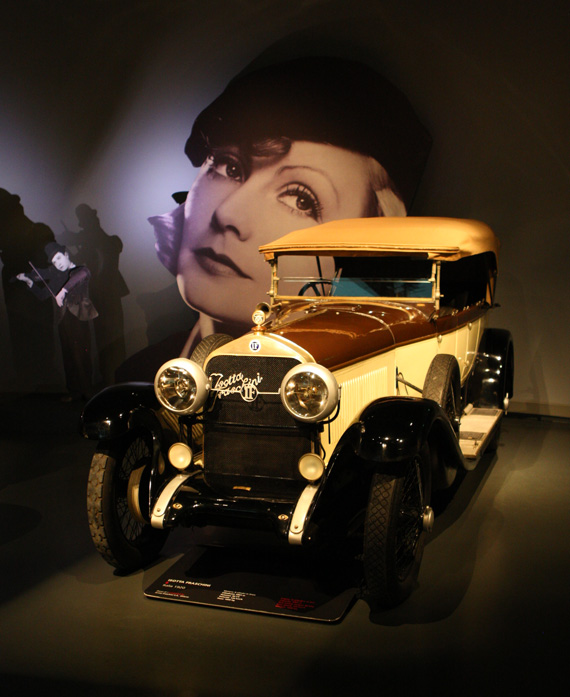
For about ten years, the Isotta-Fraschini was perhaps the world’s most refined car, a rival of Rolls-Royce’s and Hispano-Suiza’s models as the status symbol chosen by the celebrities of the hour. This one on display features a splendid example of the torpedo body designed by Castagna of Milan.
Story and photos by Jonathan Sharp
History
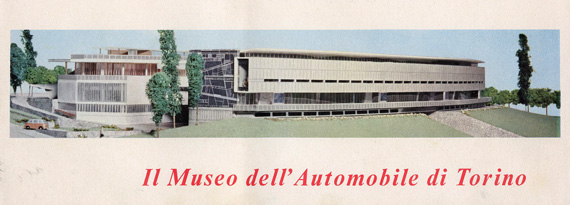
Rare document from the Museo prior to its official opening and before the death of Carlo Biscaretti in 1959.
After dropping our bags in our super nice room in the Lingotto Hotel, (See part 1) we decided to go straight to the nearby Museo dell’Automobile. I was afraid my wife Jose would stay behind, but she came along and later said that “To my amazement I really enjoyed it. Usually I go and sit in the coffee shop or sit in the car and read a book – not this time.”
I had visited the Museum in the early 1980s, when it was still known as the Carlo Biscaretti Museum. I had been very impressed with its content but not so much for the layout, which was rather old-fashioned, very much like most other museums I had visited. That is most certainly not the case now, however, as we will see.
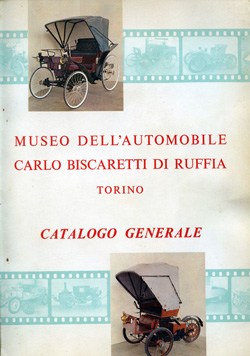 The collection itself was started in 1933 and was the idea of pioneering motorists Cesare Goria Gatti and Roberto Biscaretti Ruffia (who was the first President of the Turin Automobile Club and one of the founders of Fiat.) It was Roberto’s son Carlo for whom the Museum was named. Carlo had gathered the collection together and worked so hard during his life time to make sure the cars had a decent home.
The collection itself was started in 1933 and was the idea of pioneering motorists Cesare Goria Gatti and Roberto Biscaretti Ruffia (who was the first President of the Turin Automobile Club and one of the founders of Fiat.) It was Roberto’s son Carlo for whom the Museum was named. Carlo had gathered the collection together and worked so hard during his life time to make sure the cars had a decent home.
Following Carlo’s death in 1959 the Museum’s Board of Directors passed a resolution to name the museum after him. The Museum opened on November 3rd, 1960. The original building was designed by architect Amedeo Albertini.
In 2011 the Museum reopened following a major renovation. The winning design was by the architect Cino Zucchi, whose entry was chosen from approximately fifty of the world’s leading architects.
The Car and the 20th Century
A visit to the museum starts by taking an escalator from the ground floor Piazza directly to the top (second) floor were the story of the motor car and its relationship with man begins. This first section is named “The car and the 20th Century” with over 21 rooms totaling 3600 sq. meters telling the story from the earliest forms of locomotion right up to an exhibit called “Destiny”. “Destiny” means that we are at now at a crossroad; we can either continue on the path of environmental deterioration and destruction or take a brighter path, where our energy comes from renewable sources; along this path, we modify our life style so that it is not incompatible to the preservation of the environment. At the same time, however these first 20 rooms contain many a gem from the golden age of petrol-powered motoring.Each of the rooms has a theme, the first being “Genesis” with the replica of the 1769 steam powered Cugnot vehicle. Below, we cover most but not all of the rooms, some of which do not have an actual car featured. Most text below is credited to the Museum. Note that each subhead is a different room on the Second Floor.
Genesis
A homage to the many precursors who, over the last five centuries, have searched for a way to move and transport people and goods that was not tied to the physical strength of animals. In the Genesis library there are some of the thousands of ideas that have preceded and, in some cases, made possible, the advent of the motor car.
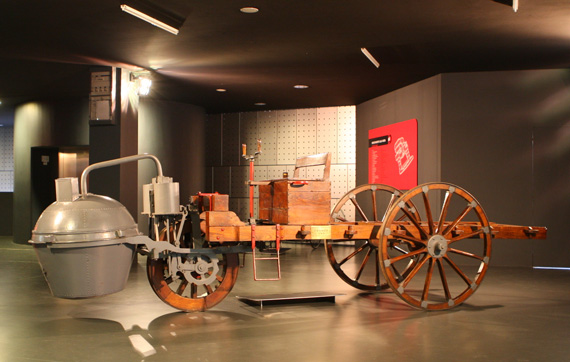
A 7:10 scale reproduction of the world’s first self-propelled vehicle, a steam-powered, tricycle artillery tractor designed in Paris’s Military Arsenal by Nicolas Joseph Cugnot of Lorraine in 1769. Its two-cylinder engine was supplied with steam by a boiler and drove the front wheel.
At Top Speed
It was soon realized that the shape of carriages could not easily be combined with speed, and we were soon to see the dawn of a new century. New shapes, such as the torpedo shape, were devised, and unheard-of speeds were reached – even over 100 km per hour, like the record set by the Belgian Camille Jenatzy’s Jamais Contente (the “hard to please” car) on 29th April 1899.
Mechanical Fervor in the Twentieth Century
The large, colorful image that makes up the backdrop is reminiscent of the works of futurism, a revolutionary artistic and cultural movement that came into being in Italy in the early twentieth century. It was one of the rare moments when art and industry blended harmoniously.
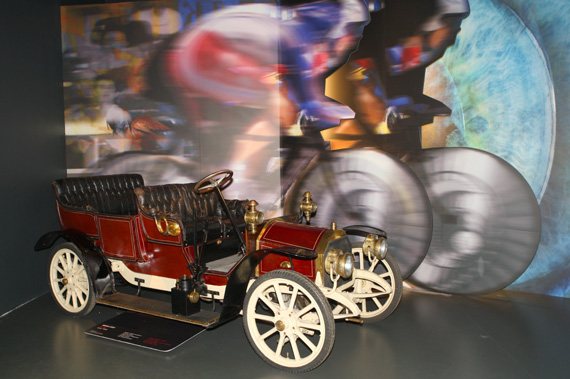
Brixia Zust 10HP image 9824 Established by Roberto Züst at Brescia in 1906, Brixia Züst was the start of what eventually became Officine Meccaniche in 1917.
Right to the Center of the World
The motor car became the means with which one could measure oneself against the impossible; in 1907 the idea was launched for an expedition to cross Asia and Europe, from Peking to Paris, over lands where there were neither roads nor possibilities for refueling.
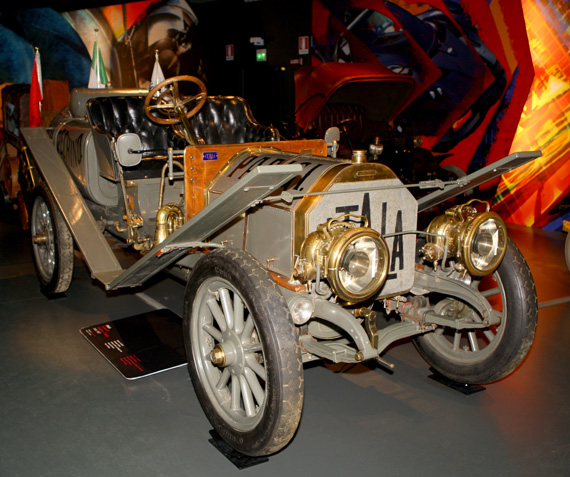
This is the Itala in which Prince Scipione Borghese with Ettore Guizzardi as his mechanic and Luigi Barzini as the special correspondent of the Corriere della Sera won the Peking to Paris race in 60 days.
The Crazy Twenties and Thirties
World War I had been left behind and life had never been so good for those lucky enough to belong to “high society”. Art Nouveau style evolved into Art Deco, ladies’ skirts got shorter, and female shapes established themselves in the most disparate fields including those traditionally reserved to men. These were the Roaring Twenties and the crazy 1930s.
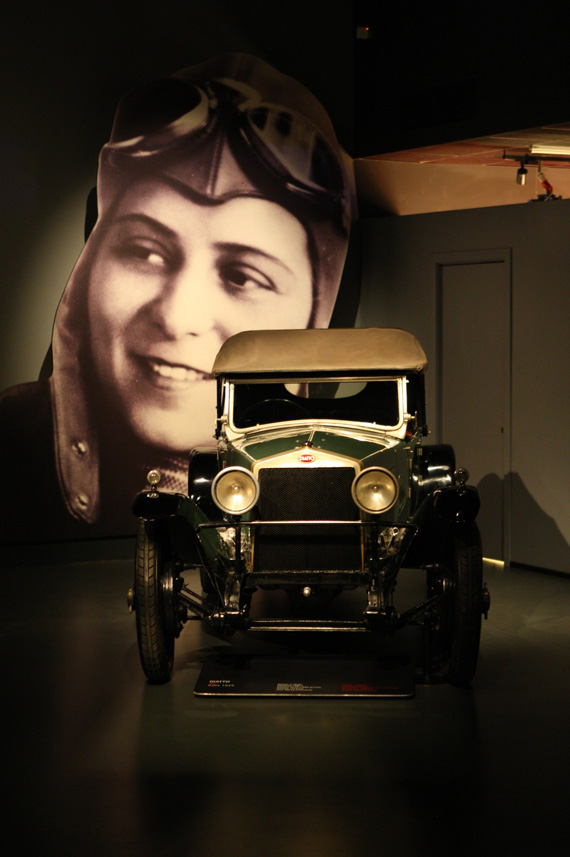
Founded in Turin in 1905, Diatto’s up-and-down history was punctuated by the production of very popular models that were often of the sporty kind. Its outstanding specifications included a powerful 2-litre engine with the overhead valve timing system Diatto had adopted in 1919.
Aerodynamics
For the first time in the design of mass-produced cars, aerodynamics, the study of the behavior of the air when penetrated by moving bodies was applied to cars. With this science, performance and road holding were improved, and the lines of the car revolutionized.
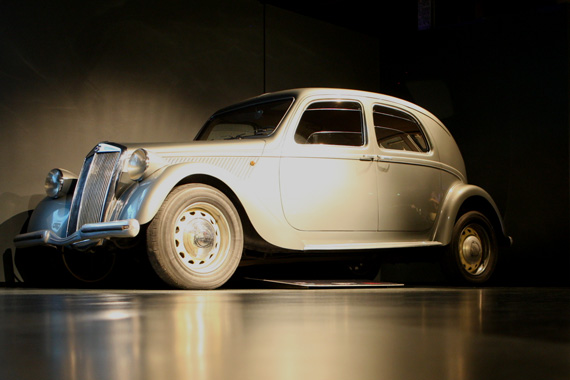
Introduced in fall 1936, the Aprilia saloon was regarded, together with the Lambda, as one of Vincenzo Lancia’s masterpieces on account of its advanced overall conception and special construction features, such as the narrow V4 engine with hemispherical combustion chambers, all-independent suspension and the aerodynamic unitary body.
All Change
The gilded world of the great European entrepreneurial aristocracy, of luxury cruise liners and sumptuous banquets, was about to be turned upside down by a set of events that would affect the whole of society, starting with the economic crisis of October 1929. New cars were put on the market in a world where the old and the new had a turbulent coexistence.
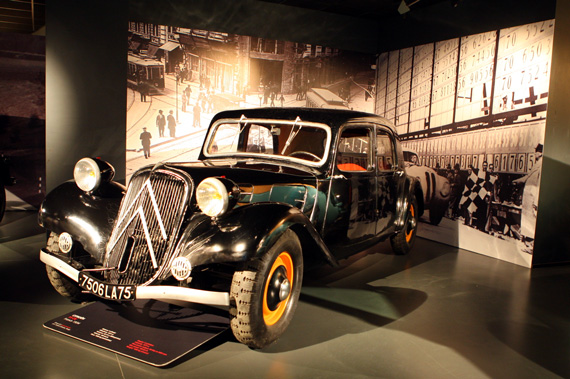
Introduced by Citroen in 1934 and soon widely referred to as the Traction Avant, this revolutionary vehicle was designed by a leading French automobile engineer, André Lefebvre. In addition to front-wheel drive (hence the nickname), its novel features included a streamlined body, steel bodyshell, independent front suspension, CV joints on the front drive shafts and torsion bar rear suspension.
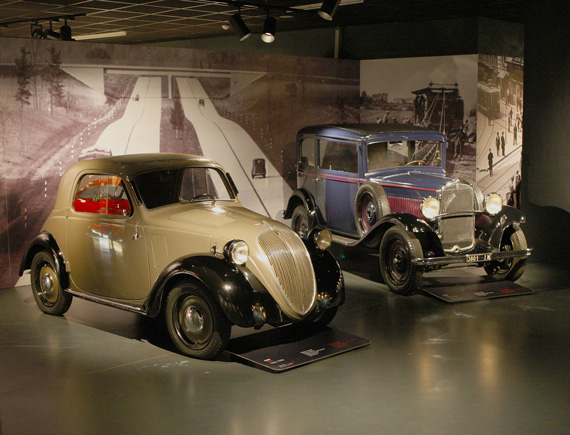
Fiat 508 1932. Presented in 1932 and soon nicknamed the Balilla, the 508 was Italy’s favorite runabout: modern with its hydraulic brakes, yet powered by a simple, less than one litre, four-cylinder, side-valve engine with a three-speed gearbox. More than 113,000 had been made when the last 508 rolled off the assembly line in 1937. Fiat 500 1936. Fiat’s 500, the popular Topolino as it was called, was the world’s smallest mass-produced car. Designed in 1936 by a young and ingenious engineer, Dante Giacosa, its mechanicals were very simple: a small four-cylinder engine overhanging the wheel axis, independent front wheels and two-seater bodywork.
The Italian Revolution
The reconstruction of Italy after World War II began with creativity and skill in designing. The car industry in Italy got back on track thanks to industrialists, engineers, designers and mechanics who started again almost from nothing. The art of creating car bodywork went through one of its most fertile periods, so that it became its own school.
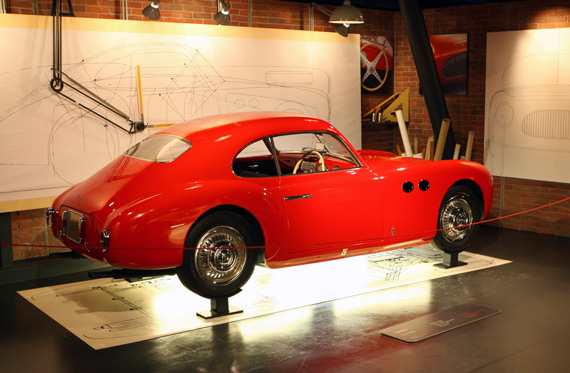
Cisitalia’s first product, the little single-seater D46, appeared in 1946. It was almost immediately accompanied by the 202 sports saloon with its tubular steel chassis and bodywork by Pinin Farina that looked ahead to the styles of tomorrow. A striking feature for those days was the horizontal radiator grille and the bonnet set below the mudguards with their built-in headlights.
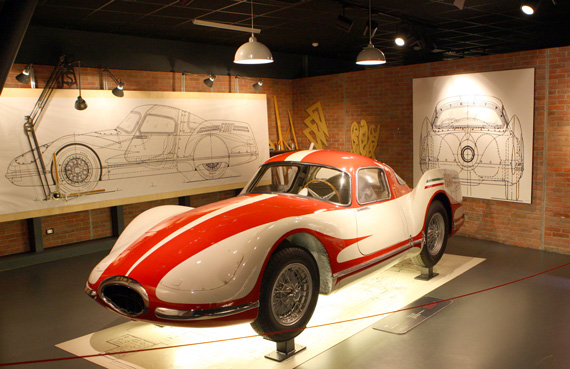
Fiat Turbina of 1954. An experimental gas-turbine-engined prototype presented by Fiat in April 1954. Propulsion is provided by a two-stage centrifugal blower coupled to a two-stage turbine and a driving turbine linked to a geared reduction unit to transmit the movement to the wheels. Model tests in the Turin Polytechnic’s wind tunnel demonstrated the excellent streamlining of the saloon’s two-seater bodywork.
Years of Recovery
The first signs of well being started to spread in Italy in the early 1950s. The Fiat 600, here in the Multipla version, gave mobility to classes of the population who had hitherto been excluded from it. These were also the years of the Giulietta Sprint – not a car for the masses, certainly, but a symbol of the beautiful Italian line.
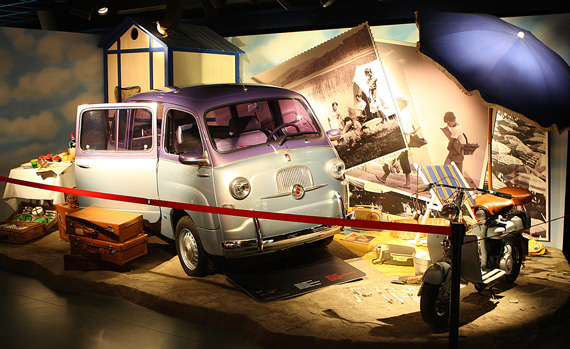
The Multipla on display was modified for the “Torino Design” exhibition in the Spring of 1995 by the designers of the IDEA Institute, who chose this car as the symbol of Italian car design and an ever-popular example of the incredibly efficient use of space, which could seat 6 people in three and a half metres!
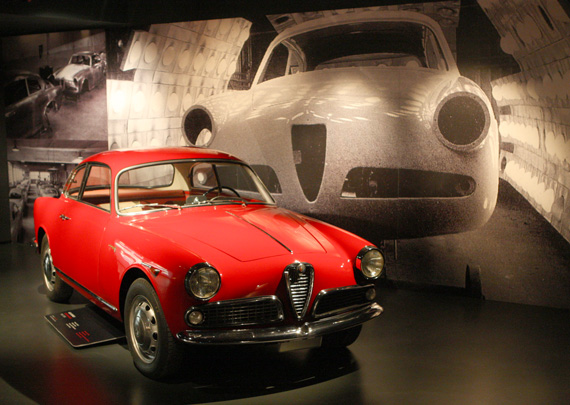
Alfa Romeo’s Giulietta Sprint with bodywork by Bertone is one of the models that best represents Italian style and automobile car engineering in the 1950s.
David and Goliath
American style against European style: Vehicles with Baroque lines, very high fuel consumption needing wide open spaces and highways, versus small cars designed to cost very little, consume less, be extremely useful and allow populations exhausted by five years of war to start to live again. There could be no more startling contrast between American designs and European ones at the end of the Fifties, as the vehicles on this display tangibly demonstrate.
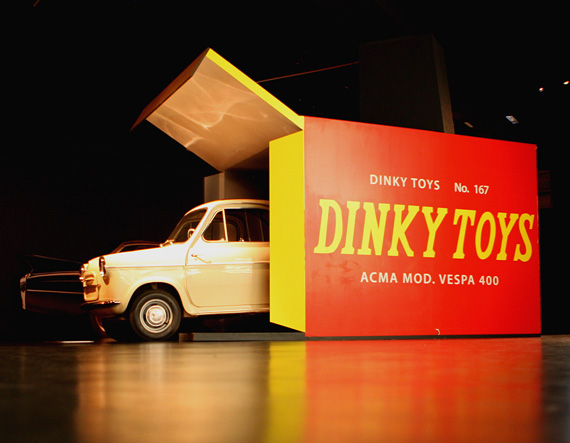
The Vespa was a small two-seater designed by Piaggio, but built and sold by the French company Acma. This simple little car was presented at the Paris Show in 1957 with a rear-mounted, twin-cylinder, two-stroke air cooled engine, three gears and a kerb weight of only 360 kg. Thanks to its size and lightness, the Vespa 400 provided handiness and low running costs.
Happiness Arrives
This is the happiness of consumerism: two showcases, inspired by those of the famous “Rinascente” Italian department store chain, offer items from the “economic boom” years that finally became affordable to many. The first electric household appliances – washing machines and fridges – arrived, television became popular and advertising became an integral part of our daily lives; we are moving into the modern age.
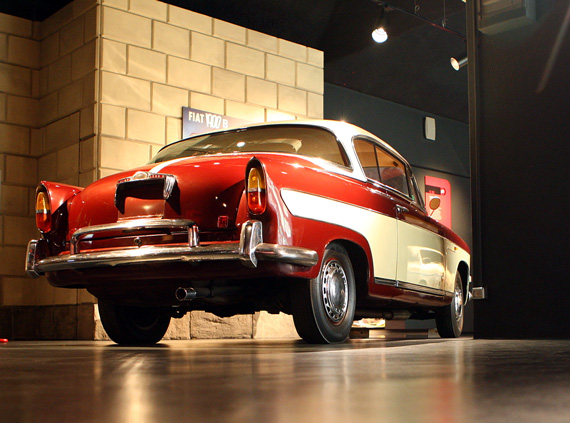
The 1900 appeared in 1952 and for some years was Fiat’s leading car. The subsequent Gran Luce version was endowed with elegance and refinement. Note the shape of the roof and large wrap-round rear window, no uprights between the side windows, the design of the radiator grille, and the two-color paintwork.
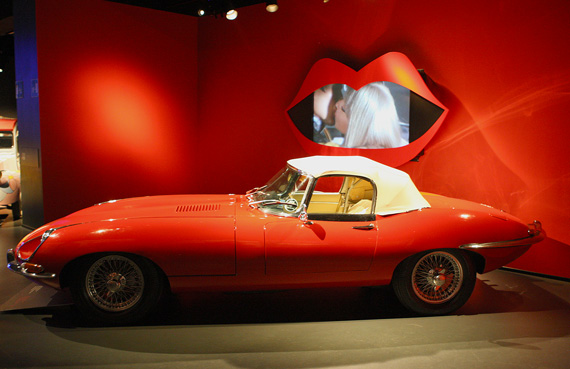
The Jaguar E GT was presented at the 1961 Geneva Automobile Show in both the coupé and open version, and was a worldwide success for the British maker. It mounted independent rear suspensions, rack and pinion steering and disk brakes.
Youth Conquers the World
Not the world, perhaps, but youth certainly conquered a different awareness of itself. The world of young people became a world apart, with its own rites, utopias, dreams, aspirations and languages. And also cars: the Citroen 2CV and the Volkswagen Transporter became universal symbols of freedom and lack of prejudice, adventure and non-conformity.

Along with the VW Microbus, the Citroen was a symbol of the years of the flower people, who sang along with the “Giganti” “Put flowers in your cannons”.
New Trends in Europe and in the World
The oil crisis of the early years of the 1970s, which hit a world that until that time, had lived as if oil were inexhaustible. Therefore on one hand, we had the glamour of extraordinary, high performance Italian cars while, on the other, fuel shortages upset whole sectors, such as the large-scale retail sector, linked industries, tourism and show-business.
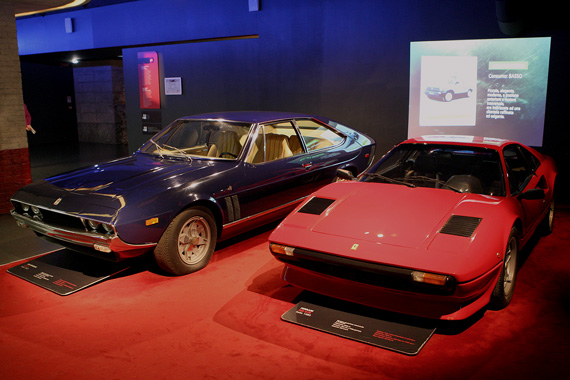
Presented at the 1975 Paris Automobile Show, the 308 GTB two-seater saloon was fast and comfortable. The streamlined body was the fruit of an extensive study in Pininfarina’s wind tunnel. The Iso Rivolta company was founded in 1939 at Bresso (Milan) by Renzo Rivolta. The firm then turned to the production of high-performance cars such as the Lele, styled by Carrozzeria Bertone with one-off bodywork for an American customer. Later a short-run production was started.
Website for futher information: Museo Dell’Automobile
Next week: The first floor and lobby.
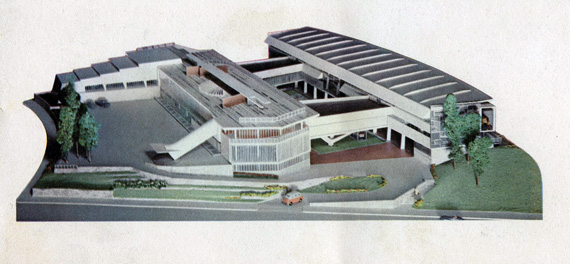
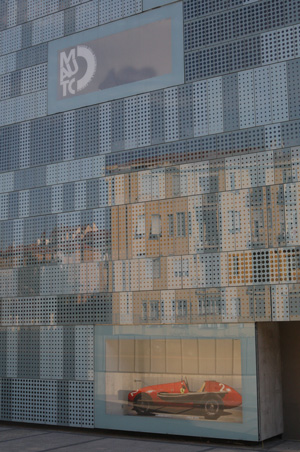
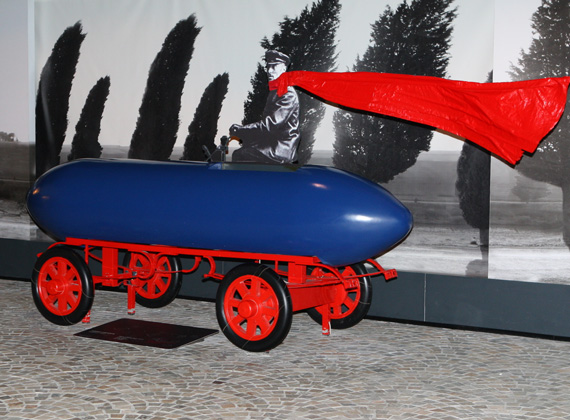
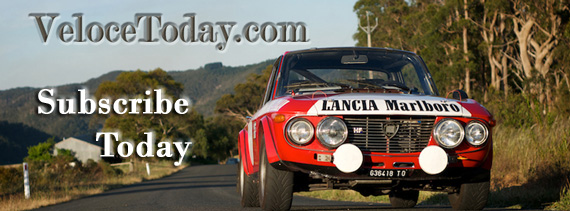
I am pleased that a renovation has taken place as my last visit about 1996 was a big disappointment. The displays were not well organized and several of the cars on disply existed as cannibalized shadows of the real thing. As an ALFA afficionado I was particularly stunned at the poor quality of the marque on display. I went from there to the Alfa museum in Arese and on to the Schlumpf collection at Mulhouse. Now it looks as if Italy has a first class Museo to rank with these offerrings.
Great memories from this article, have inspired me to make another tour in the near future. My first and last visit to the Turin Museum was in 1963 as a 9 year old !!
With two friends I visited this museum last July and said afterwards that it is the best car museum I have ever visited. I previously visited it in 1980, but at that time the main building had been damaged by a small earthquake and they only had a limited display of cars in the annexe behind. No proper displays and only bare floors and some rope barriers.
The new renovation is light years ahead of its previous ambiance, but as to re-opening in 2005 “after major renovation”, I think that should be 2011 surely? I was in Torino in 2010 and the museum was closed for the renovation works.
By the way, we also stayed in one of the hotels within the old Lingotto building (the NH Lingotto) and if you stay there you are able to borrow the key to the roof-top test track and have a walk around it (or a run as it is used as a jogging track). There was no Lancia in the foyer though.
Did you also visit Centro Storico Fiat?
Great article, looking forward to next week’s installment!
Regards,
Warren – Sydney, Australia.
Good article as is so often the case here.One thing though;I just had a look under my 1947 Citroën Traction Avant and I have to report there is a beam axle at the rear,no independent suspension there.Keep up the good work.
Michel Van Peel
I agree with Warren Smith, il Museo dell’ Automobile is absolutely fantastic. I am fortunate to work with Ferrari and Maserati and I have visited the museum while in Turin. Besides staying at the NH Lingotto please visit the Mole Antonelliana, even though it has nothing to do with cars, it houses the stunning the Museo Nazionale del Cinema, the tallest museum in the world and catching a ride its hanging glass elevator is a thrill.
Viva Italia!
Michel,
Although misleading, that is direct quote from the Museum website. However, I think it is a matter of phrasing and translations rather than an error. What they meant was “… independent front suspension and torsion bar rear suspension…” We will fix the caption accordingly, and thanks for catching this!
Pete:
I have always enjoyed a visit to the Biscaretti and they have always been helpful with material from their archive. When I was doing the Alfetta book, I asked if it would be possible to exam the Alfa 158 in detail. I was asked to wait by the car, thinking that a carefully supervised inspection would take place. In a little while, a man in overalls came up from the maitenance department with a box of tools, indicated that I should get on with it, and went away. It was amazing.
Ed
I was just there two weeks ago. We stayed at the Lingotto hotel and went up to the roof top. Sitting in the lobby to greet us was a vintage Lancia in excellent condition. The museum is an easy 20 min walk from the hotel. The day we were there it didn’t open until 2 p.m.
As to the museum there is room to expand and the cars are not at all close to each other but spaced out well so you can see them from several angles. One the first floor there is a new exhibit being put together of some design cars with a couple of Alfa’s as part of the display. The museum takes you from the very beginnings to the latest. It takes a while to get around so take your time and enjoy yourself. The parade of race cars lined up on a false track was a real delight to see. Many of the cars are put in a set display and well lit.
I hope to make it back to see what is new the next time I am in Turin.
The book store has a huge selection of books and is spacious to walk around in.